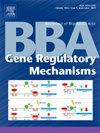全基因组筛选显示核外泌体的抑制是酿酒酵母内含子介导的增强的先决条件
IF 3.1
3区 生物学
Q3 BIOCHEMISTRY & MOLECULAR BIOLOGY
Biochimica et Biophysica Acta-Gene Regulatory Mechanisms
Pub Date : 2025-04-10
DOI:10.1016/j.bbagrm.2025.195089
引用次数: 0
摘要
内含子可以增强基因表达,这种现象被称为内含子介导增强(IME)。先前提出的IME机制并不能充分解释增强水平的可变性,这表明IME机制尚未被完全理解。全面筛选与IME有关的基因可以提供有价值的见解。最近,利用荧光素酶编码序列(yCLuc),我们发现IME的功能是缓解抑制,而不仅仅是增强表达。yCLuc的表达受特定核苷酸序列UCUU的抑制,在酿酒酵母中加入内含子可以缓解这种抑制。本文利用酿酒葡萄球菌敲除菌株文库进行全基因组筛选,以鉴定与IME相关的基因。为了筛选,yCLuc在敲除菌株中有和没有内含子表达。因此,RNA聚合酶II (RNAPII)的调节因子CDC73被确定为增强的必要条件。此外,还鉴定了23个特异性参与抑制的基因。这23个基因与核外泌体、RNA修饰、RNAPII调控、核孔复合体、核糖体和染色质修饰有关。其中,与核外泌体相关的基因对表达的影响最大,核外泌体降解细胞核中的各种rna。RNA序列UCUU已被报道为核外泌体RNA降解的靶标。这些发现表明,含有UCUU的编码序列主要通过RNA降解被核外泌体通过UCUU识别抑制,而这种抑制被内含子的存在所缓解。本文章由计算机程序翻译,如有差异,请以英文原文为准。

Genome-wide screening reveals repression by nuclear exosome as a prerequisite for intron-mediated enhancement in Saccharomyces cerevisiae
Introns can enhance gene expression, a phenomenon called intron-mediated enhancement (IME). Previously proposed IME mechanisms do not sufficiently explain the variability in enhancement levels, suggesting that IME mechanism has not been fully understood. A comprehensive screening of genes involved in IME can provide valuable insights. Recently, using a luciferase coding sequence (yCLuc), we showed that IME functions by relieving repression rather than simply enhancing expression. The expression of yCLuc is repressed by the specific nucleotide sequence UCUU, and adding an intron relieves this repression in the yeast Saccharomyces cerevisiae. Herein, genome-wide screenings were conducted using S. cerevisiae knockout strain libraries to identify genes involved in IME. For screening, yCLuc was expressed with and without an intron in knockout strains. Consequently, CDC73, a regulator of RNA polymerase II (RNAPII), was identified as essential for enhancement. Additionally, 23 genes specifically involved in the repression were identified. These 23 genes are related to nuclear exosomes, RNA modification, RNAPII regulation, the nuclear pore complex, ribosomes, and chromatin modification. Among these, genes associated with nuclear exosomes, which degrade various RNAs in the nucleus, showed the largest impact on expression. The RNA sequence UCUU has been reported as a target for RNA degradation by nuclear exosomes. These findings suggested that UCUU-containing coding sequences are primarily repressed via RNA degradation by the nuclear exosome through UCUU recognition, with this repression being relieved by the presence of an intron.
求助全文
通过发布文献求助,成功后即可免费获取论文全文。
去求助
来源期刊
CiteScore
9.20
自引率
2.10%
发文量
63
审稿时长
44 days
期刊介绍:
BBA Gene Regulatory Mechanisms includes reports that describe novel insights into mechanisms of transcriptional, post-transcriptional and translational gene regulation. Special emphasis is placed on papers that identify epigenetic mechanisms of gene regulation, including chromatin, modification, and remodeling. This section also encompasses mechanistic studies of regulatory proteins and protein complexes; regulatory or mechanistic aspects of RNA processing; regulation of expression by small RNAs; genomic analysis of gene expression patterns; and modeling of gene regulatory pathways. Papers describing gene promoters, enhancers, silencers or other regulatory DNA regions must incorporate significant functions studies.

 求助内容:
求助内容: 应助结果提醒方式:
应助结果提醒方式:


